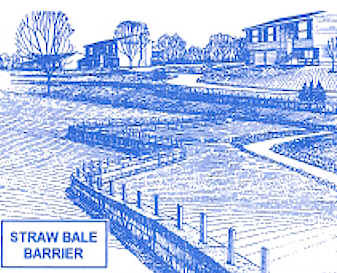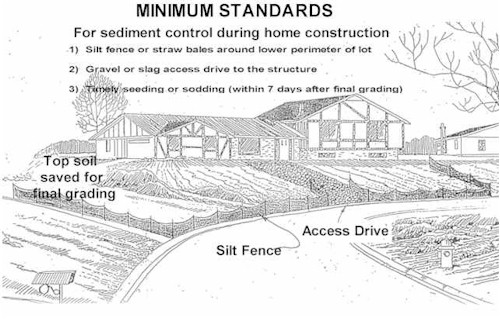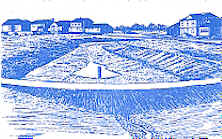You are responsible for any sediment leaving your construction site.
Principles of Erosion and Sediment Control
Erosion and sedimentation can be controlled, at reasonable cost in most cases, if certain principles are followed in the use and treatment of the land. These principles are:
- leaving the soil bare for the shortest time possible
- reducing the velocity and controlling the flow of runoff water
- retaining runoff on the site to trap sediment
Various combination of conservation practices have proved effective in applying these principles of erosion control. Here are some of the most common.
Temporary Seedlings
Any area to be left bare for more than (45) days should be seeded immediately to a temporary cover and mulched with straw. This is an inexpensive practice
that can go a long way toward avoiding costly erosion and sediment loss. A temporary seeding is designed to provide quick growth and hold the soil in
place until final grading is accomplished or a permanent seeding is established. In Warren County, temporary seeding should consist of the following:
| February 1 - August 15 |
Per 1000 Sq. Ft. |
Per Acre |
| Oats plus Annual Ryegrass |
3 lbs.
1 lb. |
128 lbs.
40 lbs. |
| August 1 - December 31 |
Per 1000 Sq. Ft. |
Per Acre |
| Rye or Wheat plus Annual Ryegrass |
3 lbs.
1 lb. |
128 lbs.
40 lbs. |
Twelve pounds of 12-12-12 fertilizer or equivalent per 1,000 square feet should also be applied at the time of seeding along with 2 to 3 bales of straw mulch.
Filter Strips
Filter strips are vegetated areas or strips for the purpose of removing sediment and other pollutants from runoff water. The minimum width for a filter
strip is 15 feet and the maximum width 100 feet. Existing vegetation, if well established, can be left undisturbed and serve as a filter strip. Developing
large tracts of land in small workable units provides filter strips by allowing construction to be completed rapidly so that large areas are not left
bare for long periods. Grading at a minimum and removing only undesirable trees, whenever possible will also help stop erosion. An ideal filter strip
should surround the entire development area. If existing vegetation is graded bare, or not well established, filter strips can be planted.
| Filter Strip Plantings |
| Seeding Mixture |
Per 1000 Sq. Ft. |
Per Acre |
Alfalfa
or Red Clover
plus Timothy
or Orchard Grass
or Bromegrass |
1/4 lb.
1/4 lb.
1/8 lb.
1/6 lb.
1/6 lb. |
10 lbs.
10 lbs.
4 lbs.
6 lbs.
6 lbs. |
Straw Bale Barriers

A straw bale barrier is a temporary sediment trap consisting of a row of entrenched and anchored straw bales. The straw allows water to pass through slowly and drop its sediment on the uphill side of the bale.
They may also be used to filter sediment from more concentrated flows in minor swales and ditch lines. The maximum contributing drainage area, however, should be no greater than 2 acres.
Straw bale barriers offer the potential benefit of double usage. Depending on the degree of disintegration, the bales can be dismantled after construction and used as mulch on the final seeding of the building site.
Silt Fencing

A silt fence is a sediment barrier consisting of a filter fabric stretched across and attached to supporting posts. Shown below is a silt fence around an individual home site.
The silt fence is entrenched much like the straw barriers and can be used in similar situations. It also has the same limitations as straw bale barriers.
Temporary Sediment Basins

Sediment basins are temporary barriers or dams, often constructed of earth, across a water course or other suitable location to retain waterborne debris.
A perforated stand pipe is usually near the dam with an underground drain that outlets the water safely downstream. The trapped water deposits its silt
load in the basin area and is relatively clean when exiting down grade via the subsurface drain. Temporary sediment basins may be used in drainage ways
with an excess of 2 acres of watershed area (where straw bales or silt fences are ineffective). Temporary sediment basins should not be installed across
drainage ways with watershed areas over 100 acres or where failure of the earthen structure would result in loss of life or property damage downstream.
The basin should be cleaned out periodically as needed and removed completely when the contributing area is vegetated and stable.
Working Together
Interest in community and area-wide planning is increasing in both urban and rural sectors. People want to get the most beneficial use out of the land,
and they want pure water and clean air. These amenities come only as a result of good planning. With proper planning and awareness erosion control on
building sites can be achieved, usually with little added cost. By working together we can have wise land use and protect our environment.
Every building site is unique. Each site poses its own restraints and potential erosion hazards. The erosion control practices in this guide are the ones most commonly employed, but they are not the only methods available. For more information regarding erosion control on construction sites, please contact:
Warren County
Soil and Water Conservation District
777 Columbus Avenue, Suite 7
Lebanon, Ohio, 45036 |
| Call Toll Free From: |
| Lebanon |
513-695-1337 |
| Cincinnati |
513-925-1337 |
| Dayton |
937-425-1337 |
| Middletown |
513-261-1337 |
| Blanchester |
513-783-4993, Ext. 1337 |